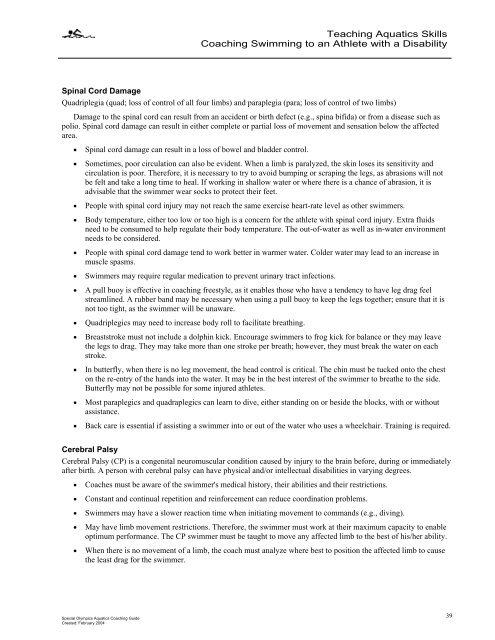Aquatics Coaching Guide - Special Olympics
Aquatics Coaching Guide - Special Olympics
Aquatics Coaching Guide - Special Olympics
You also want an ePaper? Increase the reach of your titles
YUMPU automatically turns print PDFs into web optimized ePapers that Google loves.
<strong>Special</strong> <strong>Olympics</strong> <strong>Aquatics</strong> <strong>Coaching</strong> <strong>Guide</strong><br />
Created: February 2004<br />
Teaching <strong>Aquatics</strong> Skills<br />
<strong>Coaching</strong> Swimming to an Athlete with a Disability<br />
Spinal Cord Damage<br />
Quadriplegia (quad; loss of control of all four limbs) and paraplegia (para; loss of control of two limbs)<br />
Damage to the spinal cord can result from an accident or birth defect (e.g., spina bifida) or from a disease such as<br />
polio. Spinal cord damage can result in either complete or partial loss of movement and sensation below the affected<br />
area.<br />
Spinal cord damage can result in a loss of bowel and bladder control.<br />
Sometimes, poor circulation can also be evident. When a limb is paralyzed, the skin loses its sensitivity and<br />
circulation is poor. Therefore, it is necessary to try to avoid bumping or scraping the legs, as abrasions will not<br />
be felt and take a long time to heal. If working in shallow water or where there is a chance of abrasion, it is<br />
advisable that the swimmer wear socks to protect their feet.<br />
People with spinal cord injury may not reach the same exercise heart-rate level as other swimmers.<br />
Body temperature, either too low or too high is a concern for the athlete with spinal cord injury. Extra fluids<br />
need to be consumed to help regulate their body temperature. The out-of-water as well as in-water environment<br />
needs to be considered.<br />
People with spinal cord damage tend to work better in warmer water. Colder water may lead to an increase in<br />
muscle spasms.<br />
Swimmers may require regular medication to prevent urinary tract infections.<br />
A pull buoy is effective in coaching freestyle, as it enables those who have a tendency to have leg drag feel<br />
streamlined. A rubber band may be necessary when using a pull buoy to keep the legs together; ensure that it is<br />
not too tight, as the swimmer will be unaware.<br />
Quadriplegics may need to increase body roll to facilitate breathing.<br />
Breaststroke must not include a dolphin kick. Encourage swimmers to frog kick for balance or they may leave<br />
the legs to drag. They may take more than one stroke per breath; however, they must break the water on each<br />
stroke.<br />
In butterfly, when there is no leg movement, the head control is critical. The chin must be tucked onto the chest<br />
on the re-entry of the hands into the water. It may be in the best interest of the swimmer to breathe to the side.<br />
Butterfly may not be possible for some injured athletes.<br />
Most paraplegics and quadraplegics can learn to dive, either standing on or beside the blocks, with or without<br />
assistance.<br />
Back care is essential if assisting a swimmer into or out of the water who uses a wheelchair. Training is required.<br />
Cerebral Palsy<br />
Cerebral Palsy (CP) is a congenital neuromuscular condition caused by injury to the brain before, during or immediately<br />
after birth. A person with cerebral palsy can have physical and/or intellectual disabilities in varying degrees.<br />
Coaches must be aware of the swimmer's medical history, their abilities and their restrictions.<br />
Constant and continual repetition and reinforcement can reduce coordination problems.<br />
Swimmers may have a slower reaction time when initiating movement to commands (e.g., diving).<br />
May have limb movement restrictions. Therefore, the swimmer must work at their maximum capacity to enable<br />
optimum performance. The CP swimmer must be taught to move any affected limb to the best of his/her ability.<br />
When there is no movement of a limb, the coach must analyze where best to position the affected limb to cause<br />
the least drag for the swimmer.<br />
39
















